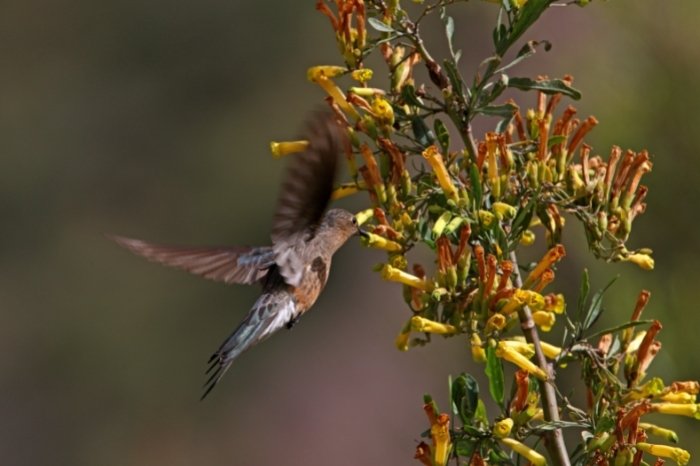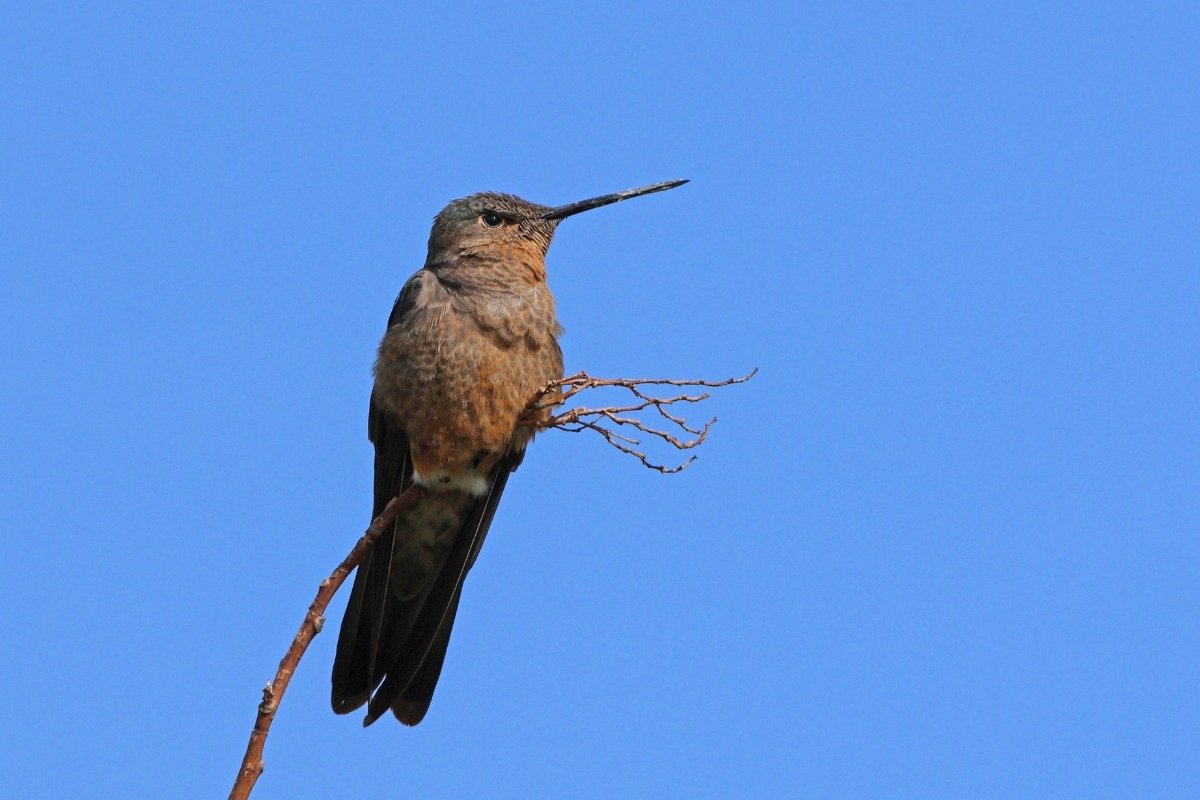Are you aware of the giant hummingbird size? Although ten times bigger than the tiniest hummingbird, this tropical bird is not that much different. It follows the same diet as your backyard hummingbirds and lives in forest areas.
Unfortunately, it’s not native nor visiting North America, so your only chance to spot one is through exploring some areas of South America. Read along if you’re curious about what this bird looks like and how it evolved.
The Giant Hummingbird
The giant hummingbird size is not the only impressive part of this bird. Patagona gigas, or the giant hummingbird, belongs to the hummingbird family and is divided into 2 species: patagona gigas gigas and patagona gigas peruviana. It’s native to South America and has a conservation status of least concern.
Although the giant hummingbird size suggests it would be heavier, this bird has a slim body covered in thicker plumage. The female’s body is gray with a lighter chest, typical dull colors. The male has a golden-colored chest and neck with green wings and back. Their beaks are long but slender.
If you ever wondered what is the largest hummingbird ever recorded, it’s the patagona gigas and its 2 subspecies.
Natural Habitat of the Giant Hummingbird
So, where does the biggest hummingbird live? You can find patagona gigas in Ecuador, Bolivia, Chile, Argentina, and other western South American states. They prefer to habituate in the Andes and live at a higher altitude, especially during the summer. Some species were found at 15,000 feet above sea level. During winter, as temperatures go down, the birds come to a lower altitude.
The giant hummingbird failed in reciprocating in such a large number to inhabit North America. But it’s still a very persistent bird. It can be harder to spot in urban areas since it looks for forests and dense vegetation.
What Does The Giant Hummingbird Eat?
Keeping in mind the giant hummingbird size you’re probably wondering what does this bird eat? Their diet is not much different than your backyard hummingbirds. The giant hummingbird also loves nectar, but it relies on flowers since it lives in more remote locations without human-provided feeders.
Due to the giant hummingbird size, its eggs are also bigger. After the breeding season, the female giant hummingbird consumes various calcium sources like sand, soil, and calcium hydroxide to replenish its calcium levels.
Protein is not a large portion of the giant hummingbird’s diet. They rely on cacti and the mesmerizing flowers of the puya genus. Due to the giant hummingbird size, it often destroys the flower while trying to reach the nectar.
What’s the Giant Hummingbird Size
The giant hummingbird is 9 inches long and has a wingspan of 8.5 inches. The average weight is around 0.7 ounces, which is fairly low for the size. This tells us that the plumage contributes to the giant hummingbird size.
For comparison, the tinies hummingbird is the bee hummingbird native to Cuba. This hummingbird is 1/10 of the giant hummingbird’s weight and 2.2 inches long.
The Hummingbird Book: The Complete Guide to Attracting, Identifying, and Enjoying Hummingbirds
But the size doesn’t come with many benefits for the giant hummingbird. It often struggles to find enough food, which can be the leading cause for this bird to become extinct with time. With the destruction of the bird’s natural habitat, there’s less space for their food to grow.
Moreover, when the giant hummingbird visits a flower searching for its nectar, it might puncture it, and the flower will die.
Mating, Nesting, And Early Life
There’s little data on the mating process of the giant hummingbird, but ornithologists believe it’s no different than the regular hummingbirds. The giant hummingbird size requires a much bigger nest for the eggs, but the location is still the same.
The mother looks for a secluded tree near a water body like a lake or spring. She lays 2 eggs per season. She is the only one laying the eggs and raising the young. The mating occurs during the summer months when the temperatures are high. The male might mate with several females in a season.
The giant hummingbird migrates to warmer South American states as winter approaches. The baby hummingbirds stay with the mother after hatching. What’s different about the giant hummingbird is that it can often be spotted in pairs and families, unlike most hummingbirds.
Quick Facts About the Giant Hummingbird
Slow Flyer
The giant hummingbird performs 10 to 15 wing flaps per second which is very slow for an ordinary hummingbird. The average for most hummingbirds is 53 flaps per second. Anna’s hummingbird is the fastest, with 80 wings flaps per second and 50mph.
The giant hummingbird glides instead of constantly flapping its wings which is not typical for hummingbirds.

Aggressive Behaviour
The giant hummingbird size requires a lot of food which makes them very defensive when it comes to food sources. They’re known to fight other hummingbirds or larger birds to defend their nectar source.
Fertility Legend
Some aboriginal tribes residing in the Andes mountains believed that the giant hummingbird grants fertility to the woman who can capture it. As a result, the bird held great importance in their folk tales and even inspired some geoglyphs.
Bottom Line: The Real Giant Hummingbird Size
It’s natural to wonder what is the largest hummingbird in North America, but what about worldwide? The Ruby-throated hummingbird is the largest in North America, but it’s significantly smaller than the giant hummingbird residing in South America.
The giant hummingbird size is not terrifying, but it’s 10 times greater than the smallest hummingbird. These birds aren’t heavy, they’re less than 1 ounce, but they’re much larger with 8.5 inches wingspan. They have a similar lifestyle to regular hummingbirds but tend to fly slower and live in more remote areas.
FAQ’s
[rank_math_rich_snippet id=”s-56afc84f-2dce-42fe-bbae-0d0d3867ffed”]


